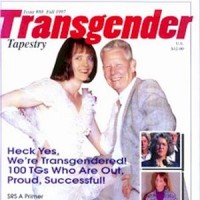“Traditional Families” (1997)

©1997, 2013 by Dallas Denny
Source: Denny, Dallas. (1997, Fall). Traditional Families. Transgender Tapestry, 80, pp. 38-39.
This appeared with an accompanying essay by Abby Saypen.
“Traditional” Families
By Dallas Denny
Human beings have always defined themselves as members of families or clans. Throughout history, families have consisted of assorted relatives including grandparents, uncles, aunts, cousins, nieces, nephews, parents, and siblings. The nuclear family— you know: Ward, June, Wally, and the Beaver— is but a couple of hundred years old, having come into existence at the convenience of the Industrial Revolution and having reached its zenith on the Zenith— with the television family of the 1950s. This is the family the radical religious right calls the “traditional” family, but it is hardly traditional. It is a fiction, a composite taken from the television shows “Ozzie and Harriet,” “Leave It to Beaver,” “The Desi Arnez Show,” and “Father Knows Best.” The right is hardselling this idealized vision of the nuclear family to anyone who will listen. Family Values. Copyright 1997, Jerry Falwell Ministries. Now a Paramount Motion Picture starring Glenn Close as Lucy, Hugh Grant as her husband Ricardo, and young Bart Simpson as Little Ricky.
1950s style television families never really existed— or rather they did in a way, since real-life people attempted to emulate them— but life in this type of family was not as it was pictured on the black-and-white set in the living room. Sure, everything looked fine on the surface, Mr. and Mrs. Cleaver, young master Wallace, and little Theodore all living in the house on the corner, but it was all based on appearance. There was much turmoil under the surface. The Motorola in the living room didn’t tell us Ward kept a mistress and about once a month would drink too much and work June over enough to send her to the hospital. It didn’t tell us June was an alcoholic and had long had a thing going with Lumpy’s mother; that Eddy Haskell’s favorite hangout was the men’s room at the bus station and in fact, that was where he met Wally; that the Beaver was a compulsive masturbator and it was he who was stealing women’s underwear from the neighborhood clotheslines, that Lumpy’s father was sexually molesting both Lumpy and his nine-year-old daughter. Face it: Ward was a philanderer and a sadist, June was an alcoholic and a bisexual, Eddie and Wally were gay, the Beaver was a budding transvestite and would one day seek sex reassignment, Lumpy’s father was a pedophile, and Lumpy himself would buy the farm fighting a senseless and unjust war in Vietnam. The TV didn’t tell us about June’s DUIs, Wally’s arrest for soliciting an undercover cop in the park, the juvenile proceedings against the Beaver when the police found hundreds of pairs of panties in his closet, or how Ward shanghaied Grandma and Grandpa Cleaver into Shady Rest Nursing Home.
In promoting their vision of the “family,” the radical right is not pro-family at all. What the right favors is a deviant 1950’s Ward and June Cleaver lily-white sensibility that sacrifices substance for style. Rather that acknowledging its diversity and facing its problems, the “traditional” family of the radical right sweeps everything (and everyone) under the carpet. It ignores substance abuse, gives license to spousal and child abuse, keeps gay, lesbian, bisexual, and transgendered folk in the closet, and gives us all a white, heterosexual middle-class barf-city “ideal” to emulate. It not only ignores the hundreds of thousands of years in which real families lived and worked together, but Orwells the extended family out of existence by using the term “traditional” to describe something that has not been around very long at all and doesn’t exist in actuality anyway. Ultimately, the radical right’s “traditional” family sacrifices not only the individual, but the family itself.
The true “traditional” family is the extended family, and I believe it is the model we should be working to preserve.
